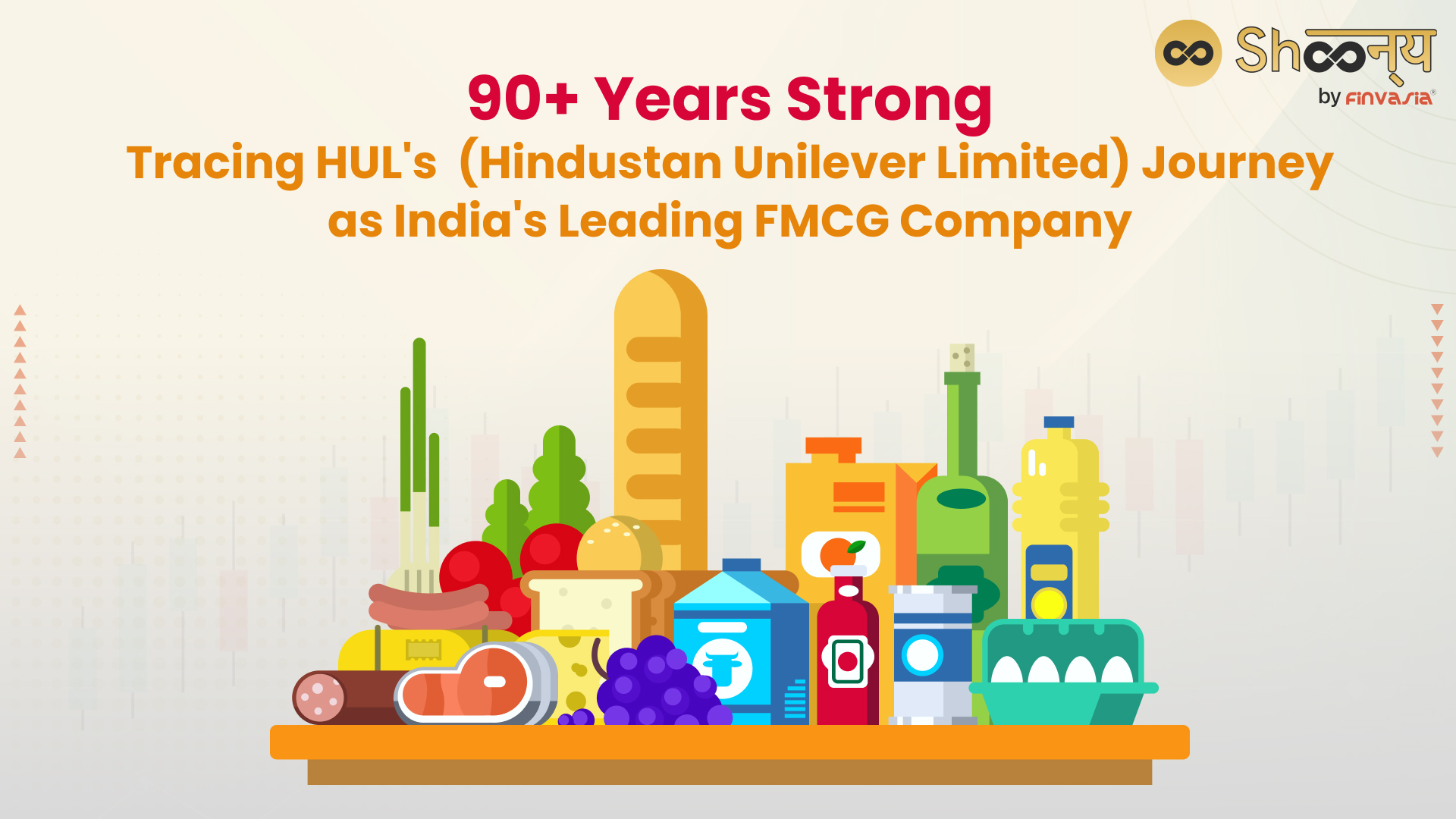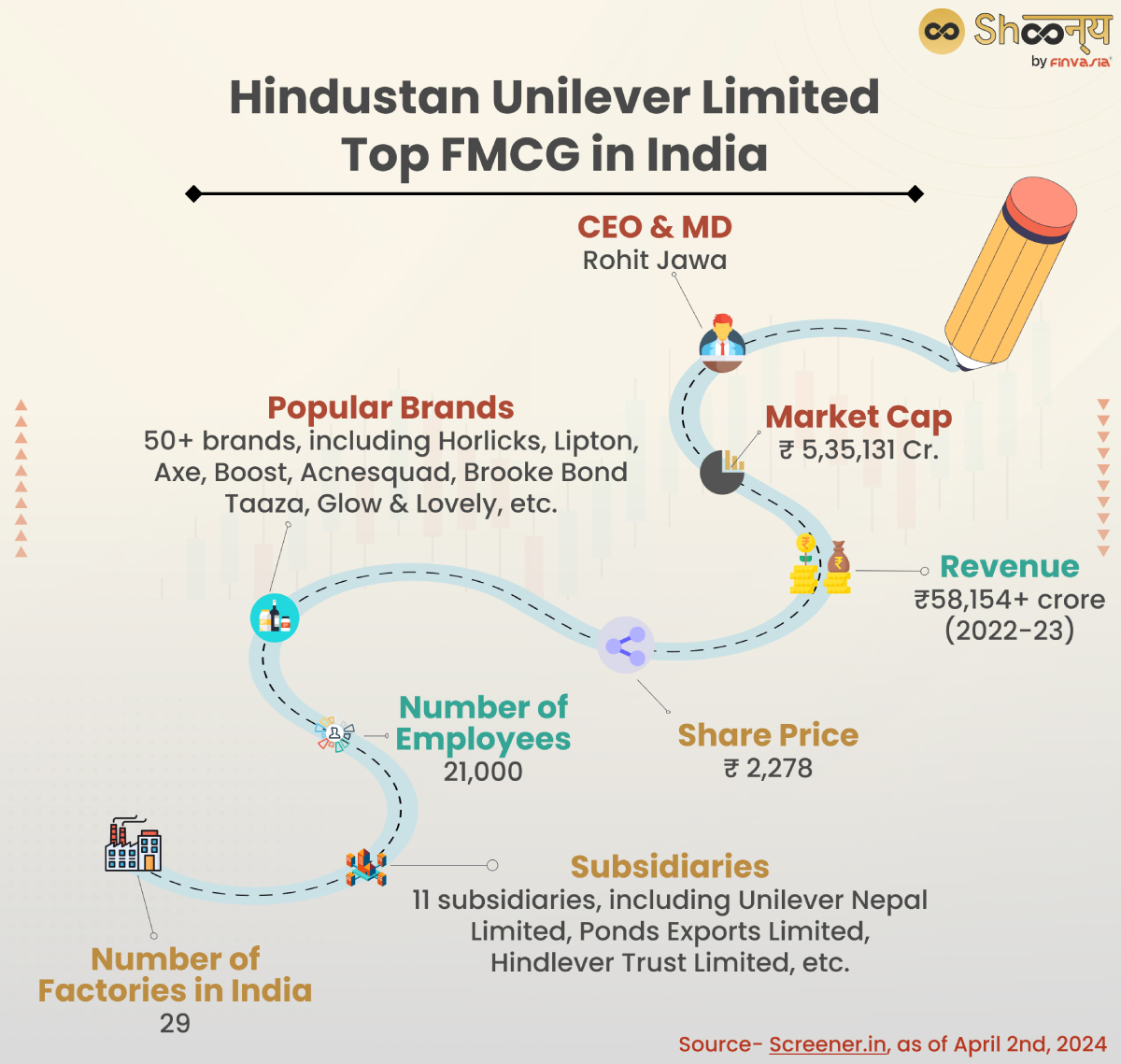Explore the Rich History of Hindustan Unilever Limited (HUL)

If someone were to ask you about the first soap you used for germ protection, the answer would likely be Lifebuoy. And what about your favourite and oldest tea brand? Brooke Bond, isn’t it? And let’s not forget household favourites like Ponds cream, Horlicks, Bru coffee, Lipton tea—the list is endless. From the refreshing scent of Lifebuoy soap to the creamy indulgence of Kwality Wall’s Kornetto, the history of Hindustan Unilever Limited (HUL) itself embodies a story of tradition, innovation, and, above all, love from the heart of India. Lux soap’s film-star glamour, the reassuring purity of Lifebuoy, and the vibrant colours of Lakmé cosmetics are cherished parts of Indian heritage.
Today, let’s walk you through the history of Hindustan Unilever, starting from the 1900s when HUL started its first subsidiary in India.
Hindustan Unilever Limited – Top FMCG in India

| CEO & MD | Rohit Jawa |
| Market Cap | ₹ 5,35,131 Cr. |
| Share Price | ₹ 2,278 |
| Revenue | ₹58,154+ crore (2022-23) |
| Subsidiaries | 11 subsidiaries, including Unilever Nepal Limited, Ponds Exports Limited, Hindlever Trust Limited, etc. |
| Number of Employees | 21,000 |
| Number of Factories in India | 29 |
| Popular Brands | 50+ brands, including Horlicks, Lipton, Axe, Boost, Acnesquad, Brooke Bond Taaza, Glow & Lovely, etc. |
Source- Screener.in, as of April 2nd, 2024
About Hindustan Unilever Limited – Top FMCG Company in India
Hindustan Unilever Limited (HUL) has a rich presence of over 90 years in the nation. The history of Hindustan Unilever spreads across 50+ brands, 21000 employees, multiple products and much more!
- Hindustan Unilever Origin Country: India
- Hindustan Unilever CEO & MD Rohit Jawa leads the company’s strategic direction.
- Hindustan Unilever Popular Brands: It has a rich portfolio of over 50 popular brands, including household names such as Horlicks, Lipton, Axe, Boost, Acnesquad, Brooke Bond Taaza, Glow & Lovely, etc.
- Hindustan Unilever Market Cap: As of April 3rd, 2024, HUL has an impressive market capitalisation of ₹ 5,35,131 Crores.
- Hindustan Unilever Share Price: As of April 3rd, 2024, HUL’s share price values ₹ 2,278.
- Hindustan Unilever Limited Products: HUL offers a wide variety of products under categories like Foods and Beverages, home care, Personal Care, and Water Purifiers.
Foods: Bru Coffee, Knorr Soups, Kissan Jams, Magnum Ice Cream, etc.
Homecare: RIN, Surf Excel Detergent, Vim Dishwash, and Domex Disinfectant, etc.
Personal Care: Dove Skincare, Vaseline Hand Lotion, Dove Shampoo and Conditioner, Pepsodent Toothpaste, Axe Deodorants, etc.
Beverages: Tea, coffee and other drinks.
- Tea: Brooke Bond and Lipton brands
- Coffee: BRU Instant and BRU Gold in Instant coffee, BRU Green Label and BRU Select in Filter coffee, etc.
- Drinks: Horlicks, a powered-based milk mixture issued under brands like Horlicks, Horlicks Lite, Horlicks Mother’s Plus, etc.
- Hindustan Unilever Revenue: In the fiscal year 2022-23, HUL reported a substantial revenue of ₹58,154+ Crores.
- Hindustan Unilever Number of Employees: A dedicated workforce of 21,000 employees.
- HUL factories in india: 29
Hindustan Unilever Subsidiaries
1. Unilever India Exports Limited
2. Lakme Lever Private Limited
3. Unilever India Limited
4. Unilever Nepal Limited
5. Ponds Exports Limited
6. Jamnagar Properties Private Limited
7. Daverashola Estates Private Limited
8. Levers Associated Trust Limited
9. Levindra Trust Limited
10. Hindlever Trust Limited
11. Bhavishya Alliance Child Nutrition Initiatives
History of Hindustan Unilever: Largest FMCG in India
Hindustan Unilever Limited (HUL) has a rich 90-year+ legacy in India.
It has a robust portfolio of 50+ brands across 16 FMCG categories. As a subsidiary of Unilever, a global leader in Food, Home Care, Personal Care, and Refreshment products, HUL aligns with a strong mission.
Let us take a look at the interesting growth History of Hindustan Unilever.
Expansion and Innovation: HUL’s Early Years (1888-1914)
It was in the scorching summer of 1888, curious onlookers at the bustling Kolkata harbour were greeted by a peculiar sight. There were crates brimming with Sunlight soap bars proudly imprinted with the declaration, “Made in England by Lever Brothers.”
Thus commenced a revolutionary chapter in the history of Fast Moving Consumer Goods (FMCG).
The late 19th century witnesses the dawn of Hindustan Unilever Limited (HUL) with the introduction of Sunlight soap in India in 1888.
The subsequent decades saw the launch of various iconic products such as Lifebuoy soap in 1895, Pears soap in 1902, and Lux flakes in 1905.
Meanwhile, the company establishes its presence across major cities like Mumbai, Chennai, Kolkata, and Karachi, appointing agents and expanding its reach.
1888: Sunlight soap makes its debut in India.
1895: HUL introduces Lifebuoy soap, followed by the appointment of agents in major cities like Mumbai, Chennai, Kolkata, and Karachi.
1902: Pears soap joins the product lineup, expanding HUL’s offerings in the Indian market.
1903: Brooke Bond Red Label tea launches, catering to the tea-loving population of India.
1905: Lux flakes hit the shelves, offering consumers a new way to care for their clothes.
1913: Vim scouring powder lands into the wide portfolio of HUL.
1914: Vinolia soap enters the Indian market, enhancing HUL’s range of personal care items.
Strides of Growth: HUL’s Evolution (1918-1939)
In the midst of this growth era, Hindustan Unilever Limited was born through the merger of Lever Brothers and Margarine Unie.
Subsequently, Unilever established its first Indian subsidiary, Hindustan Vanaspati Manufacturing Company.
The 1930s witnessed further expansion with the incorporation of Lever Brothers India Limited.
1918: Vanaspati, introduced by Dutch margarine manufacturers, adds another dimension to HUL’s product range.
1922: Rinso soap powder enters the market, providing consumers with a convenient laundry solution.
1924: Gibbs dental preparations make their debut, addressing oral hygiene needs.
1925: Lever Brothers gains full control of the North West Soap Company, consolidating its presence in the market.
1926: Hartogs registers the Dalda trademark, a significant milestone in the cooking oil segment.
1930: Unilever was born through the merger of Lever Brothers and Margarine Unie, laying the foundation for a global consumer goods giant.
1931: The registration of Hindustan Vanaspati Manufacturing Company marks the beginning of manufacturing operations in India.
1932: Soap manufacturing begins at the Sewri factory, establishing a local production base.
1934: Incorporation of Lever Brothers India Limited.
1935: Formation of United Traders to market personal products, expanding HUL’s reach across the country.
1937: Prakash Tandon, one of the first Indian covenanted managers, joins HVM, marking a shift towards indigenous leadership.
Growth and Milestones: HUL in the 1940s and 1950s
The tumultuous decades of the 1940s and 1950s bring both challenges and opportunities for HUL.
Amidst World War II and India’s struggle for independence, the Hindustan Unilever company continues.
It starts initiatives like training Indians for management positions and focusing on building up brands like Dalda Vanaspati.
1941: Unilever decides to train Indians for management positions, fostering indigenous talent development.
1943: Personal Products manufacturing begins in India, catering to local preferences and needs.
1947: The launch of India’s most loved Pond’s Cold Cream.
1951: Prakash Tandon becomes the first Indian Director.
1956: Birth of Hindustan Unilever Limited through the merger of three companies, with increased Indian equity participation.
1959: HUL makes a history.
Launches Surf.
Consolidation and Expansion: HUL’s Journey in the 1960s and 1970s
Indigenous leadership takes centre stage, with Prakash Tandon assuming the role of the first Indian Chairman in 1961.
The company diversifies into new sectors like chemicals and modernises its manufacturing facilities.
Meanwhile, iconic brands like Sunsilk shampoo and Rin bar are born.
1961: Prakash Tandon becomes the first Indian Chairman, marking a significant milestone in indigenous leadership.
1966: Indian shareholding in the company increases, reflecting local confidence and investment.
1971: Approval of Diversification into Chemical.
1976: Modernization plans for soaps and detergent plants.
1979: Comission of Sodium Tripolyphosphate plant at Haldia.
Transformation and Leadership: HUL’s Growth in the 1980s and 1990s
The 1980s and 1990s witness HUL’s evolution into a modern consumer goods giant.
By the late 1990s, HUL establishes itself as a market leader.
1984: Foods and animal feed businesses transfer to Lipton.
1988: Launch of legendary Lipton Taaza tea.
1992: HUL recognized as a Star Trading House in Exports by the Government of India.
1995: HUL enters the branded staples business with salt, diversifying its product offerings further.
1997: Establishment of International Research Laboratory.
New Horizons: HUL’s Journey in the 2000s
The turn of the millennium heralds a new era of growth and transformation for HUL.
The company expands its footprint with acquisitions like Modern Food Industries Ltd.
2005: Harish Manwani assumes the role of Chairman, ushering in a new era of leadership.
2007: The company formally changes its name to Hindustan Unilever Limited, reflecting its unified identity.
2010: HUL moves to its new headquarters ‘Unilever House’, in Mumbai.
HUL’s Progression from 2013 to 2023
The recent years see HUL’s continued focus on innovation, sustainability, and growth.
As the company celebrates its milestones, including completing 80 years in 2013 and achieving a turnover of INR 50,000 Crore in 2022.
2014: The ‘Winning in Many Indias’ operating framework launches nationally, focusing on regional diversity.
2020: Merger with GSK Consumer Healthcare expands HUL’s portfolio.
2022: HUL’s turnover crosses the INR 50,000 Crore mark.
2023: Rohit Jawa is appointed as the CEO and Managing Director, bringing new leadership to drive the company forward.
Through over a century of innovation, expansion, and adaptation, Hindustan Unilever Limited has remained at the forefront of India’s consumer goods industry, enriching lives and touching hearts across the nation.
Hindustan Unilever Limited (HUL): Top ESG-rated FMCG company in India
Through over a century of innovation, expansion, and adaptation, Hindustan Unilever Limited has remained at the forefront.
- HUL pledges to cut its carbon footprint in manufacturing operations.
- HUL focuses on initiatives that positively impact the planet, emphasising waste management and water conservation.
- Guided by their ‘Clean Future’ agenda, the company is advancing towards a more environment-friendly product line. Their laundry formulations aim to save water.
- Reduced plastic footprint by replacing virgin plastic with post-consumer recycled plastic across brands like Vim, Surf excel, Vaseline, Rin.
- HUL uses environment-friendly solutions for the production of soda ash and silicate, which are integral components of laundry detergents.
FAQs|History of Hindustan Unilever
HUL began with the introduction of Sunlight soap in India in 1888 and has grown into India’s largest FMCG company with a wide range of products.
HUL has been present in India for over 90 years, since its establishment in the late 19th century.
The full form of HUL is Hindustan Unilever Limited.
HUL offers a diverse portfolio, including soaps, detergents, shampoos, skincare, tea, coffee, and packaged foods.
Source– screener.in, hul.co.in
______________________________________________________________________________________
Disclaimer: Investments in the securities market are subject to market risks; read all the related documents carefully before investing.








